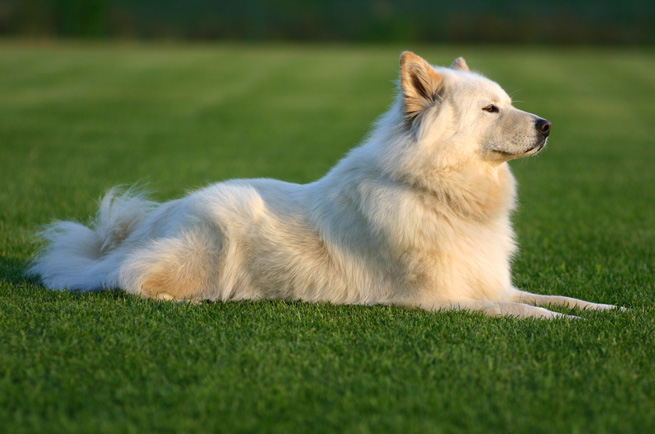Samoyed
Affectionately known as the Smiling Sled Dog, the Samoyed is a breed designed to work in the freezing cold arctic conditions. Not surprisingly they are build to withstand such cold temperatures and to do it with a smile! Their coat is thick and weather resistant and their wide padded feet act like snowshoes for this hardy dog. Even better their feet have so much hair between their toes that they can't get snowballs stuck in which could stop them working. The Samoyed has a happy face with wide pricked ears and a curled tail, it's no surprise they are said to be smiling!
Other Names
Sami, Sammy, Samoyedskaya, Smiling Sled Dog
Country of Origin
Siberia
Colour
Samis are various shades of white, including creamy and pure tones.
Size
Large
Height / Weight
Height 51-56cms at the withers; bitches should measure between 46-51cms. Weight 23-30kgs.
Health
The Sami tends to be a hardy dog without many significant health problems. Some of their more common ailments include hip dysplasia due to their high level of activity, as well as deafness and some eye problems. Breeders are doing well to manage the instances of these conditions with screenings.
Life Span
14 - 15 years
Intelligence
The Sami is a loyal and hard working dog but you must earn their respect first. Can be quite difficult to train, their independence and wilful nature requires firm and patient training. A particularly noisy and vocal breed, start managing their barking from an early age.
Exercise
High
Suitability (Children)
Low
Feeding
The Samoyed is very energetic and requires enough food to fuel their active lifestyle.
Feeding Cost
$15-$20 p/w
Other Cost
Excercise
The Samoyed is a very active and exuberant animal. To keep them happy they will need a lot of exercise, including some time to run freely off the lead. As sled dogs they have been bred to pull and can sometimes drag against you when walking them, make sure to rain them well to heel and walk beside you!
Hair Shed
Little
Ailments
The Sami tends to be a hardy dog without many significant health problems. Some of their more common ailments include hip dysplasia due to their high level of activity, as well as deafness and some eye problems. Breeders are doing well to manage the instances of these conditions with screenings.
Grooming
The beautiful white coat of the Samoyed will need a fair amount of upkeep to look it's best. Brushing them daily is a must with a more thorough run over weekly. If your Sami decides to play in the mud, don't worry! Let it dry and it should fall from the hair as you comb it out. The thick coat of the Samoyed will have a full shed once a year generally, but in warmer climate like Australia this could occur twice a year. While the dog is shedding you will find their hair absolutely everywhere, when you think it's over there will be even more, the best thing to do is persist with their grooming routine and be grateful it only happens once or twice a year!
Grooming Frequency
Daily and more thoroughly once a week.
Trimming
Heavy
The Smiling sled dog first earnt its keep herding and guarding Reindeer in Northern Russia where it was named after the nomadic tribe it lived with. This was no usual working dog, the Sami was a much loved member of the family who shared the tent of their tribe. The Samoyed was also used to pull sleds or boats and when there was greater polar exploration they travelled home with many an explorer. The Samoyed became really popular after a couple introduced them from Russia to Britain in the early 1900s and remain a well loved breed today.
comments powered by Disqus



